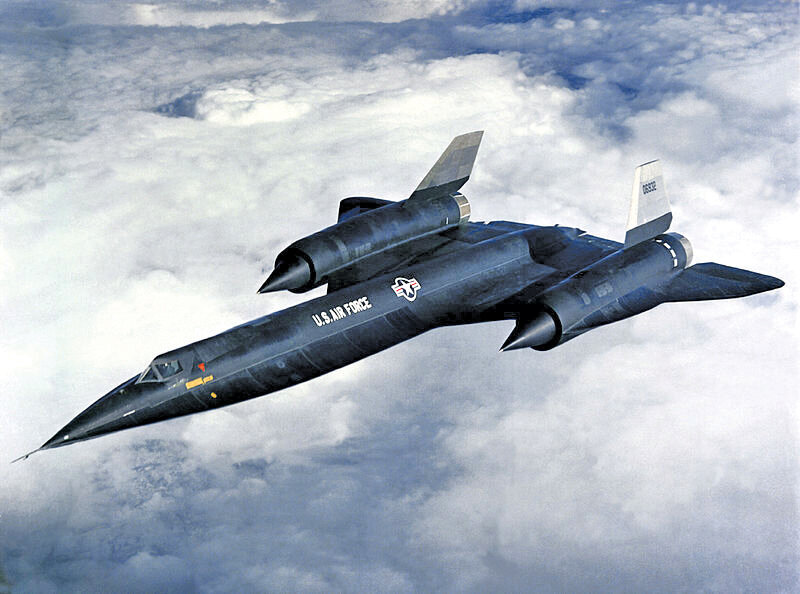Aviation Ancestry - October 2012
From “Gusto” to “Oxcart”
By Scott Schwartz
Lockheed A-12 in flight. Although nearly identical to the later SR-71, the A-12 was designed for the CIA. (Photo courtesy of the USAF)“Faster than a speeding bullet.” That phrase is rarely used in reference to an aircraft, but the SR-71 was one of those rare cases.
Conceived during a time when over-flights of the Soviet Union were part of the United States’ cold war strategy, the idea that eventually became the SR-71 originated back in 1955. During that year, Kelley Johnson and Richard Bissell (both of the famous Lockheed “Skunk Works”) began to think about building an aircraft that did not possess the high-flying U-2’s major weakness: the ease with which it could be tracked by Soviet radar. Many readers will recall that the U-2 was originally designed for a “customer” other than the U.S. Air Force. In addition, Lockheed’s un-named (at the time) customer had unsuccessfully tried to reduce the U-2’s radar signature under “Project Rainbow.”
Research revealed that, in order for an aircraft to fly over the Soviet Union with minimal risk of detection, it would have to fly very high and very fast. Plus, the hypothetical aircraft would need a low radar cross-section. Well, let’s face it, Kelly and his engineers were really thinking of an aircraft that could fly through Soviet air space with virtual impunity.
This translated into an airplane that could fly at 90 thousand feet while cruising at mach three. Plus, it’s small radar signature would require the aircraft to possess what we now call “stealth” characteristics. The result would be an aircraft that was as different from the U-2 as a Boeing 747 is from a sailplane. Well, okay, the U-2 was a powered sail-plane – sort of. But that story is best saved for another article. Johnson and his colleagues sketched out numerous shapes and configurations, ultimately winding up with an aircraft that looked a lot like the Convair B-58 Hustler. In April of 1958 (two years prior to Francis Gary Powers and his U-2 being shot down), Johnson pitched his proposal to the Air Force.
Originally referred to as Archangel, the proposed aircraft was re-dubbed Archangel II after a few revisions to the design (the U-2 had been code-named Angel) and was to be powered by two Pratt & Whitney J58 turbo-jet engines, as well as with two ram-jet engines. All this would have enabled Archangel II to cruise at Mach 3 while flying at 90 thousand feet. Well, this design was “shot down” by the Air Force because the ram jets required the use of exotic fuel.
Head-n view of a Lockheed A-12. Notice the “chines” on either side of the fuselage. These were incorporated into the design in order to produce lift. (Roy Smith)Undeterred, because he planned on revising the design numerous times, Johnson went back to the drawing board. Throughout the following months, Johnson and his team created numerous designs, rejecting some, blending features from rejected concepts into the succeeding ones. Most of this design work was done using slide rules and drawings. Eerily prophetic was the fact that Lockheed’s test results indicated that wedge-shaped surfaces tended to deflect radar waves. Lockheed incorporated this concept, as well as the inward-canting vertical stabilizers forever associated with the SR-71 into what became known as the Archangel or A-7. Further development led yet another Archangel design – the A-11. Since the A-11’s radar signature was deemed by Lockheed’s mysterious “customer” to be too high, the “stealthier” elements of the A-7 were incorporated into the A-11, which led to a new design: the A-12.
The A-12’s general configuration was based on extensive wind-tunnel data; the “chines” running along the forward fuselage generated lift. To keep the radar signature to a minimum, the engines were placed mid-wing, so that the shock wave generated at the aircraft’s Mach 3.2 cruising speed would not enter the inlets.
Once the design had been finalized, both the Central Intelligence Agency (by now, readers have probably identified the CIA as Lockheed’s mysterious customer, referred to earlier) and the Air Force (which, much to its displeasure, had been forced to relinquish most strategic aerial reconnaissance activities to the CIA) would be keeping tabs on the project. For its part, Lockheed formed its own evaluation team, which was led by Dr. Edwin Land, who invented the Polaroid camera. At this point, the A-12 was given the code name “Gusto.”
Once the A-12 design was formally accepted, Kelly Johnson was told that the acceptance was under the condition that work to further reduce the aircraft’s radar signature.
The A-12 project was formally accepted on Aug. 28, 1958. With that, Kelly Johnson expected the aircraft’s first flight to take place within a mere 20 months. With a $96.6 million contract to build five A-12s within the next 24 months, Lockheed’s “Project Gusto” gave way to “Project Oxcart.”
To be continued…
Visit the author’s blog at www.elpasomountains.blogspot.com


